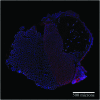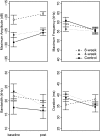Laryngeal Neuromuscular Response to Short- and Long-Term Vocalization Training in Young Male Rats
- PMID: 30950702
- PMCID: PMC6436889
- DOI: 10.1044/2018_JSLHR-S-18-0316
Laryngeal Neuromuscular Response to Short- and Long-Term Vocalization Training in Young Male Rats
Abstract
Purpose Although vocal training is often purported to restore and rebalance laryngeal muscle function, little is known about the direct effects of vocal training on the laryngeal muscles themselves. Consequently, parameters of vocal exercise dose, such as training duration and intensity, have not been well defined. The goal of this study was to use a behavioral animal model to determine the effects of short- and long-term ultrasonic vocalization (USV) training on USV acoustics, thyroarytenoid (TA) muscle neuromuscular junctions (NMJs), and TA muscle fiber size in adult rats. Method Twenty-four young adult male Long-Evans rats were divided into 3 groups (untrained control, 4-week training, and 8-week training). Baseline and posttraining USVs were recorded and acoustically analyzed for fundamental frequency, frequency bandwidth, amplitude, and duration. Presynaptic and postsynaptic NMJ morphological features and muscle fiber size were measured in the TA. Results USV training had no effect on USV acoustics. Eight weeks of USV training, however, resulted in a lower NMJ motor endplate dispersion ratio, consistent with previous findings. USV training did not affect fiber size within the TA muscle. Conclusions This study demonstrated that 8 weeks of USV training can induce peripheral neural adaptations in the NMJ of the TA muscle in young rats. The observed adaptations suggest that vocal training is consistent with endurance-type exercise, but the adaptations occur on a longer time scale than similar adaptations in the limb muscles.
Figures






References
-
- American College of Sports Medicine. (2009). American College of Sports Medicine position stand. Progression models in resistance training for healthy adults. Medicine and Science in Sports and Exercise, 41(3), 687–708. - PubMed
-
- Andonian M. H., & Fahim M. A. (1988). Endurance exercise alters the morphology of fast- and slow-twitch rat neuromuscular junctions. International Journal of Sports Medicine, 9(3), 218–223. - PubMed
-
- Baechle T., & Earle R. (2000). Essentials of strength and conditioning: National Strength and Conditioning Association. Champaign, IL: Human Kinetics.
Publication types
MeSH terms
Grants and funding
LinkOut - more resources
Full Text Sources

